Shoichi Koyama
Past, Present, and Future of Spatial Audio and Room Acoustics
Mar 17, 2025Abstract:The study of spatial audio and room acoustics aims to create immersive audio experiences by modeling the physics and psychoacoustics of how sound behaves in space. In the long history of this research area, various key technologies have been developed based both on theoretical advancements and practical innovations. We highlight historical achievements, initiative activities, recent advancements, and future outlooks in the research area of spatial audio recording and reproduction, and room acoustic simulation, modeling, analysis, and control.
Sound Field Estimation: Theories and Applications
Mar 13, 2025Abstract:The spatial information of sound plays a crucial role in various situations, ranging from daily activities to advanced engineering technologies. To fully utilize its potential, numerous research studies on spatial audio signal processing have been carried out in the literature. Sound field estimation is one of the key foundational technologies that can be applied to a wide range of acoustic signal processing techniques, including sound field reproduction using loudspeakers and binaural playback through headphones. The purpose of this paper is to present an overview of sound field estimation methods. After providing the necessary mathematical background, two different approaches to sound field estimation will be explained. This paper focuses on clarifying the essential theories of each approach, while also referencing state-of-the-art developments. Finally, several acoustic signal processing technologies will be discussed as examples of the application of sound field estimation.
* published in Foundations and Trends in Signal Processing, vol. 19, no. 1; see https://www.nowpublishers.com/article/Details/SIG-121
Physics-Informed Machine Learning For Sound Field Estimation
Aug 27, 2024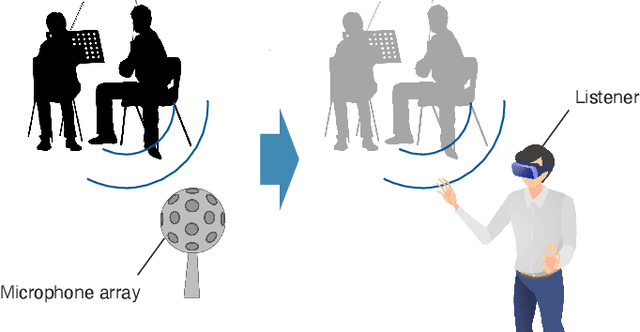
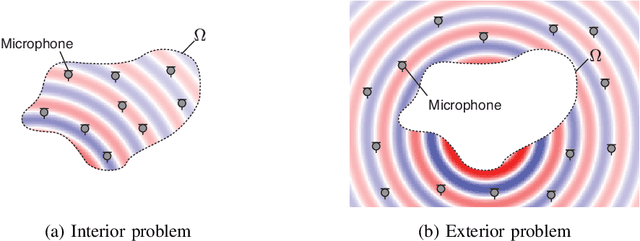
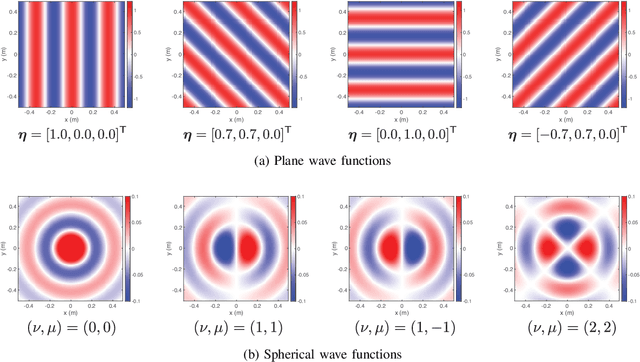
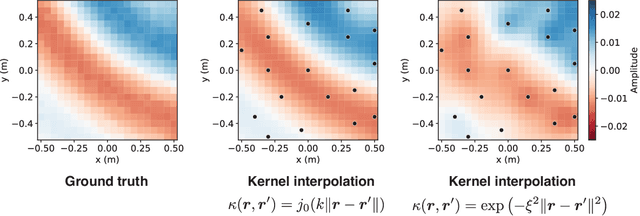
Abstract:The area of study concerning the estimation of spatial sound, i.e., the distribution of a physical quantity of sound such as acoustic pressure, is called sound field estimation, which is the basis for various applied technologies related to spatial audio processing. The sound field estimation problem is formulated as a function interpolation problem in machine learning in a simplified scenario. However, high estimation performance cannot be expected by simply applying general interpolation techniques that rely only on data. The physical properties of sound fields are useful a priori information, and it is considered extremely important to incorporate them into the estimation. In this article, we introduce the fundamentals of physics-informed machine learning (PIML) for sound field estimation and overview current PIML-based sound field estimation methods.
Sound Field Estimation Using Deep Kernel Learning Regularized by the Wave Equation
Jul 05, 2024Abstract:In this work, we introduce a spatio-temporal kernel for Gaussian process (GP) regression-based sound field estimation. Notably, GPs have the attractive property that the sound field is a linear function of the measurements, allowing the field to be estimated efficiently from distributed microphone measurements. However, to ensure analytical tractability, most existing kernels for sound field estimation have been formulated in the frequency domain, formed independently for each frequency. To address the analytical intractability of spatio-temporal kernels, we here propose to instead learn the kernel directly from data by the means of deep kernel learning. Furthermore, to improve the generalization of the deep kernel, we propose a method for regularizing the learning process using the wave equation. The representational advantages of the deep kernel and the improved generalization obtained by using the wave equation regularization are illustrated using numerical simulations.
Localizing Acoustic Energy in Sound Field Synthesis by Directionally Weighted Exterior Radiation Suppression
Jan 11, 2024Abstract:A method for synthesizing the desired sound field while suppressing the exterior radiation power with directional weighting is proposed. The exterior radiation from the loudspeakers in sound field synthesis systems can be problematic in practical situations. Although several methods to suppress the exterior radiation have been proposed, suppression in all outward directions is generally difficult, especially when the number of loudspeakers is not sufficiently large. We propose the directionally weighted exterior radiation representation to prioritize the suppression directions by incorporating it into the optimization problem of sound field synthesis. By using the proposed representation, the exterior radiation in the prioritized directions can be significantly reduced while maintaining high interior synthesis accuracy, owing to the relaxed constraint on the exterior radiation. Its performance is evaluated with the application of the proposed representation to amplitude matching in numerical experiments.
Kernel Interpolation of Incident Sound Field in Region Including Scattering Objects
Sep 11, 2023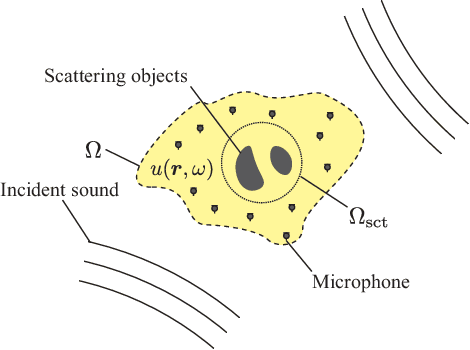
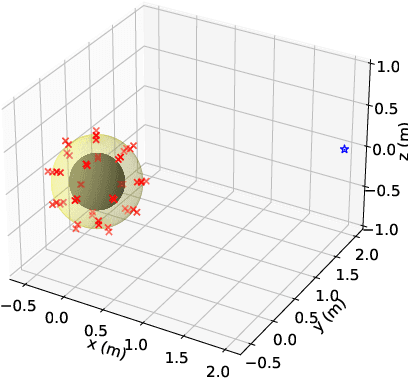
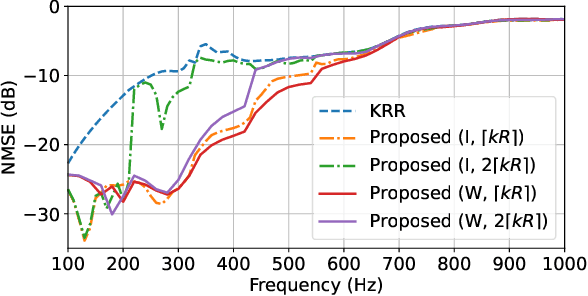
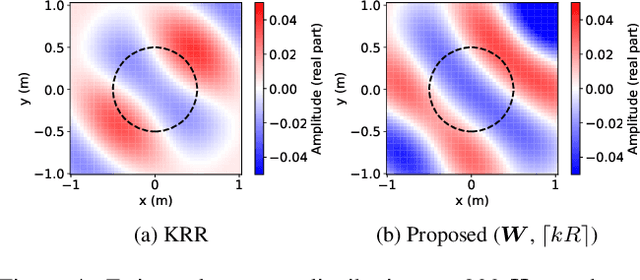
Abstract:A method for estimating the incident sound field inside a region containing scattering objects is proposed. The sound field estimation method has various applications, such as spatial audio capturing and spatial active noise control; however, most existing methods do not take into account the presence of scatterers within the target estimation region. Although several techniques exist that employ knowledge or measurements of the properties of the scattering objects, it is usually difficult to obtain them precisely in advance, and their properties may change during the estimation process. Our proposed method is based on the kernel ridge regression of the incident field, with a separation from the scattering field represented by a spherical wave function expansion, thus eliminating the need for prior modeling or measurements of the scatterers. Moreover, we introduce a weighting matrix to induce smoothness of the scattering field in the angular direction, which alleviates the effect of the truncation order of the expansion coefficients on the estimation accuracy. Experimental results indicate that the proposed method achieves a higher level of estimation accuracy than the kernel ridge regression without separation.
Perceptual Quality Enhancement of Sound Field Synthesis Based on Combination of Pressure and Amplitude Matching
Jul 26, 2023Abstract:A sound field synthesis method enhancing perceptual quality is proposed. Sound field synthesis using multiple loudspeakers enables spatial audio reproduction with a broad listening area; however, synthesis errors at high frequencies called spatial aliasing artifacts are unavoidable. To minimize these artifacts, we propose a method based on the combination of pressure and amplitude matching. On the basis of the human's auditory properties, synthesizing the amplitude distribution will be sufficient for horizontal sound localization. Furthermore, a flat amplitude response should be synthesized as much as possible to avoid coloration. Therefore, we apply amplitude matching, which is a method to synthesize the desired amplitude distribution with arbitrary phase distribution, for high frequencies and conventional pressure matching for low frequencies. Experimental results of numerical simulations and listening tests using a practical system indicated that the perceptual quality of the sound field synthesized by the proposed method was improved from that synthesized by pressure matching.
Multichannel Active Noise Control with Exterior Radiation Suppression Based on Riemannian Optimization
Jun 15, 2023Abstract:A multichannel active noise control (ANC) method with exterior radiation suppression is proposed. When applying ANC in a three-dimensional space by using multiple microphones and loudspeakers, the loudspeaker output can amplify noise outside a region of target positions because most of current ANC methods do not take into consideration the exterior radiation of secondary loudspeakers. We propose a normalized least mean square algorithm for feedforward ANC in the frequency domain based on the Riemannian optimization to update the control filter with the exterior radiation power constrained to a target value. The advantages of the proposed method, compared with the algorithm using a penalty term of exterior radiation, were validated by numerical experiments: the exterior radiation power can be constrained during the adaptation process and the parameter for the constraint can be determined in advance.
Kernel-interpolation-based spatial active noise control with exterior radiation suppression
Mar 31, 2023Abstract:A spatial active noise control (ANC) method based on kernel interpolation of a sound field with exterior radiation suppression is proposed. The aim of spatial ANC is to reduce incoming noise over a target region by using multiple secondary sources and microphones. The method based on kernel interpolation of a sound field allows noise attenuation in a regional space with an array of arbitrary geometry. The cost function is defined as the acoustic potential energy, i.e., the regional integral of the power distribution inside the target region. However, this cost function does not take into consideration the exterior radiation of secondary sources. Thus, the acoustic power in the exterior region can be amplified by the output of the secondary sources. We propose two spatial ANC methods with exterior radiation suppression. The first approach is based on the minimization of the cost function formulated as a sum of the interior acoustic potential energy and exterior radiation power. The second approach is based on the minimization of the interior acoustic potential energy with inequality constraints on the exterior radiation power. Adaptive algorithms for minimizing the cost function are derived for the two approaches. Numerical experimental results indicate that the proposed methods can reduce the interior regional noise while suppressing the exterior radiation.
Spatial Active Noise Control Method Based On Sound Field Interpolation From Reference Microphone Signals
Mar 28, 2023Abstract:A spatial active noise control (ANC) method based on the interpolation of a sound field from reference microphone signals is proposed. In most current spatial ANC methods, a sufficient number of error microphones are required to reduce noise over the target region because the sound field is estimated from error microphone signals. However, in practical applications, it is preferable that the number of error microphones is as small as possible to keep a space in the target region for ANC users. We propose to interpolate the sound field from reference microphones, which are normally placed outside the target region, instead of the error microphones. We derive a fixed filter for spatial noise reduction on the basis of the kernel ridge regression for sound field interpolation. Furthermore, to compensate for estimation errors, we combine the proposed fixed filter with multichannel ANC based on a transition of the control filter using the error microphone signals. Numerical experimental results indicate that regional noise can be sufficiently reduced by the proposed methods even when the number of error microphones is particularly small.
 Add to Chrome
Add to Chrome Add to Firefox
Add to Firefox Add to Edge
Add to Edge